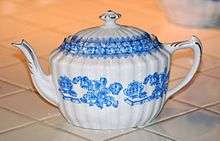Transferware


Transferware is a style of ceramics including pottery, dinnerware, and other delicate items. It uses transfer printing, a decorative technique which was developed in England in the mid-18th century, particularly around the Staffordshire region.
The process starts with an engraved copper plate similar to those used for making paper engravings. The plate is used to print the pattern on tissue paper, then the tissue paper transfers the wet ink to the ceramic surface. The ceramic is then fired in a low temperature kiln to fix the pattern. This can be done over or under the glaze, but the underprinting method is more durable. The process produces fine lines similar to the engraved prints in old books. Before transfer printing ceramics were hand painted, a laborious and costly process.
Twentieth century major English manufacturers include Crown Ducal, Enoch Wood, Royal Staffordshire, Royal Crownford, Alfred Meakin (Tunstall), Spode, Johnson Brothers, and Mason's. The process was popular in other countries including Germany. One particularly distinctive type of transferware, with an all-over floral pattern, is called chintz pottery, or chintzware.[1]
References
- ↑ Bagdade, Susan & Al (2004). Warman's English & continental pottery & porcelain (4th ed.). Iola, WI: KP Books. pp. 51–52. ISBN 9780873495059. Retrieved 6 June 2014.
- transferwarecollectorsclub.org
- Joe Keller and Mark Gibbs, English Transferware: Popular 20th Century Patterns. ISBN 0-7643-2348-2
- Gillian Neale, Miller's: Encyclopedia of British Transfer-Printed Pottery Patterns, 1790 - 1930. Mitchell Beazley 2005, ISBN 1-84533-003-X